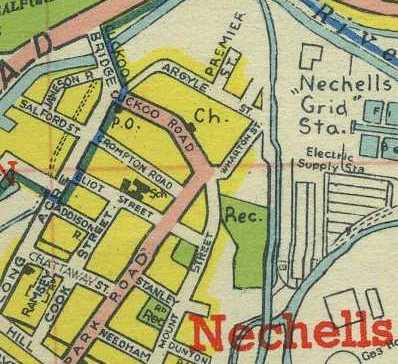 Within
the area of responsibility of the 25th Warwickshire (Birmingham)
Battalion fell the factory of
M.B.
Wild & Co. Ltd.
of Argyle Street, Nechells, Birmingham. M.B. Wild
was heavily involved in the war effort as were all mechanical
engineering companies at the time. Among its products
were balloon winches*
and the Wild military assault bridge**
(see below). The Company also was one of
a number of manufacturers of the Universal Carrier, better
known as the Bren Gun Carrier, a light tracked vehicle
which was an essential part of the equipment of the British
Army and other forces. Some 113,000 of these were built
worldwide. There are memories of the test route taken
as each vehicle was completed at the factory and started
up. It would go out along Argyle Street, then right into
Wharton Street, and then right again
Within
the area of responsibility of the 25th Warwickshire (Birmingham)
Battalion fell the factory of
M.B.
Wild & Co. Ltd.
of Argyle Street, Nechells, Birmingham. M.B. Wild
was heavily involved in the war effort as were all mechanical
engineering companies at the time. Among its products
were balloon winches*
and the Wild military assault bridge**
(see below). The Company also was one of
a number of manufacturers of the Universal Carrier, better
known as the Bren Gun Carrier, a light tracked vehicle
which was an essential part of the equipment of the British
Army and other forces. Some 113,000 of these were built
worldwide. There are memories of the test route taken
as each vehicle was completed at the factory and started
up. It would go out along Argyle Street, then right into
Wharton Street, and then right again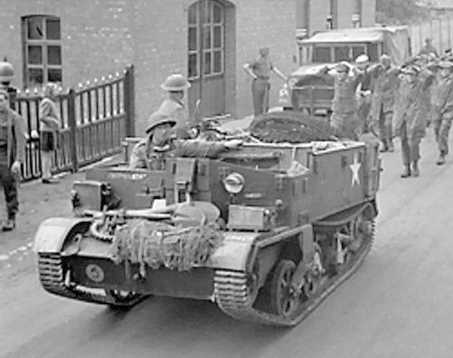 down Cuckoo Road, completing the circuit and no doubt
accompanied by the mixture of roaring engine, whirring
transmission and clattering tracks remembered by anyone
who has ever witnessed one of these vehicles being driven
on metalled roads. (It is safe to assume that the example
shown right heading a column of prisoners-of-war was photographed
a long way from the streets of Nechells). The employees
of M.B. Wild were proud that their first production batch
of carriers saw service at El Alamein.
down Cuckoo Road, completing the circuit and no doubt
accompanied by the mixture of roaring engine, whirring
transmission and clattering tracks remembered by anyone
who has ever witnessed one of these vehicles being driven
on metalled roads. (It is safe to assume that the example
shown right heading a column of prisoners-of-war was photographed
a long way from the streets of Nechells). The employees
of M.B. Wild were proud that their first production batch
of carriers saw service at El Alamein.
THE FAMILY
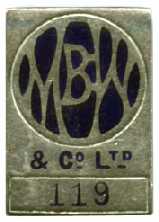 Like
so many similar factories this company had its own, separate
Home Guard unit manned by volunteer employees which became
part of the 25th Battalion.
Mr.
Harry Poppitt, Works Manager of the factory
both during and after the war, was a member of the works
unit. His father,
Mr. William
Poppitt, and his brother-in-law,
Mr.
Harold Roe both undertook
fire-watching duties at the same factory.
(The
family
Like
so many similar factories this company had its own, separate
Home Guard unit manned by volunteer employees which became
part of the 25th Battalion.
Mr.
Harry Poppitt, Works Manager of the factory
both during and after the war, was a member of the works
unit. His father,
Mr. William
Poppitt, and his brother-in-law,
Mr.
Harold Roe both undertook
fire-watching duties at the same factory.
(The
family
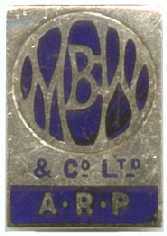 may
well have had other, earlier links with the company: records
show that an employee named Charles Poppitt
may
well have had other, earlier links with the company: records
show that an employee named Charles Poppitt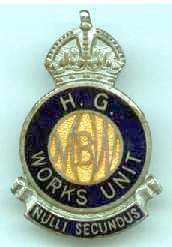 served in the King's
Shropshire Light Infantry
during the Great War). Harry Poppitt was at some stage
a member of the A.R.P. This service may or may not have
been concurrent with his Home Guard activity but possibly
preceded it. His A.R.P. badge survives
(left) as do his Company identity and Home
Guard badges (right).
served in the King's
Shropshire Light Infantry
during the Great War). Harry Poppitt was at some stage
a member of the A.R.P. This service may or may not have
been concurrent with his Home Guard activity but possibly
preceded it. His A.R.P. badge survives
(left) as do his Company identity and Home
Guard badges (right).
In 1943 Harry Poppitt volunteered - or
was volunteered - for officer training. It is probable
that he was a contemporary of Arthur Musson (see above)
in this endeavour; the two men certainly knew each other
at this time. In November 1943 he was commissioned after
successful completion of the course and became 2/Lt. W.
H. Poppitt. He received a note of congratulation and exhortation
dated 25th November 1943 from the Battalion's Adjutant,
Captain James G. ?Lawrence.
Whilst he must have been gratified to receive this, one
can only speculate at his reaction to the reference to
"hard work"; the newly commissioned 2/Lt Poppitt
was after all a man who was already heavily engaged in
helping to run a frantically busy industrial company,
at the same time as engaging in Home Guard and possibly
A.R.P. activities and also trying to keep a family together
and safe. This is the letter.
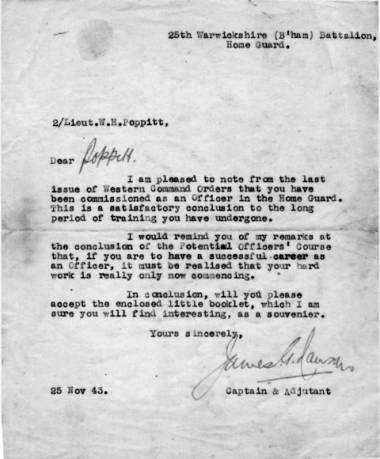
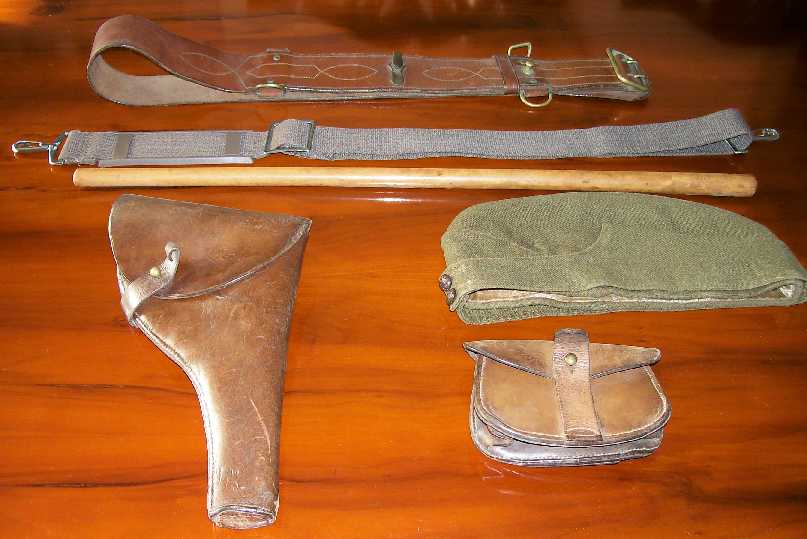
Some of 2/Lt. Poppitt's
kit survives, lovingly preserved by his family. Here it
is, photographed almost exactly 63 years since it was
last used, Sam Brown, Webbing Belt, Swagger Stick, Gun
Holster, Bullet Pouch and Cap.
In December 1944 Harry Poppitt's services
in the defence of his country were no longer required.
The Home Guard rather "fizzled out" in the autumn
of 1944 to some dismay and irritation; but its Stand-Down
was marked by a massive, formal parade in Central London
participated in by representatives from every battalion
in the kingdom. A similar parade took place through central
Birmingham on Sunday December 3rd 1944 at which the 25th
Warwickshire (Birmingham) Battalion would have been well
represented. Mr. Poppitt was free
thereafter to concentrate on his civilian responsibilities
at M.B. Wild & Co. which he retained all through the
difficult post-war years and beyond. His devotion to the
Company was legendary and there is a story of his completing
a job by undertaking the final painting of a not-quite-finished
product on the back of a lorry even as it was being delivered
to a customer. And his adherence to his trusty push-bike
for much of his service to Company and Home Guard is still
fondly remembered.
Harry continued
to work at M.B. Wild & Co long after his normal retirement
date. But one cold January day in 1984 he was taken ill
at work and passed away shortly afterwards at the age
of 74. He is still remembered with deep
affection by his family.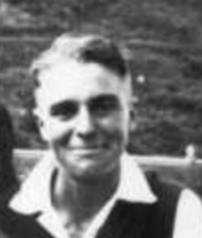
Harry Poppitt (October 30th 1909
- January 24th 1984)
May this page stand as a minor commemoration
of Harry Poppitt and the countless thousands of Home Guards
like him - men who gave their all for the industrial war
effort over five long years and yet still, somehow, found
the energy and determination to devote what little spare
time they had to the defence of their families, factories,
homes and neighbourhoods.
********************
OTHER INFORMATION
*There is online
information about winch technology which mentions the
contribution of M.B. Wild & Co.
here.
**And about
the
Wild
assault bridge. (You
will leave this site in each case).